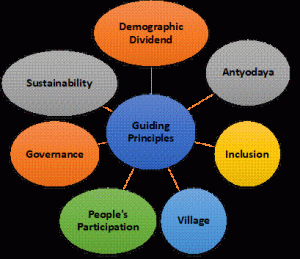Table of Contents
THE ECONOMIC DEVELOPMENTS
1. INDIA’S TRADE DEFICIT WITH CHINA HIT A RECORD $77 BN IN FY22
THE CONTEXT: China’s General Administration of Customs (GACC) data showed that India’s exports to China stood at $26.46 billion while its imports from China stood at $103.47 for April 2021 to March 2022.
THE EXPLANATION:
- Despite the government’s ‘Atmanirbhar Bharat’ push and attempts to reduce the nation’s dependence on goods manufactured in China, India’s trade deficit with the neighbouring country hit a record $77 billion from April 2021 to March 2022.
- Electrical and electronic goods, machinery and fertilizers are the main drivers of India’s imports from China, according to the Federation of Indian Export Organisations (FIEO), the apex trade promotion body under India’s commerce ministry.
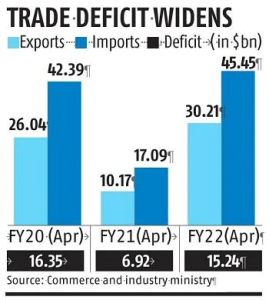
- Unlike the GACC, which has provided data for the month of March 2022 the Indian commerce ministry has only furnished figures up to February this year (2022). From the Indian side, the trade deficit so far stands at approximately $65.34 billion from April 2021 to February 2022.
- According to commerce ministry data, this is still far higher than what was recorded in previous years – the trade deficit stood at $53.57 billion in 2018-19, $48.65 billion in 2019-20 and $44.02 billion in 2020-21.
- In fact, the trade deficit breached the $60 billion-mark was in 2017-2018 at $63 billion. Reports at the time attributed this to the significant decline in India’s exports of ores and cotton to China.
POINTS TO REMEMBER:
India’s total trade with China was $125.7 billion in 2021. The sharp uptick in imports has pushed India’s trade deficit with China to $69.4 billion in 2021, up from $45.9 billion in 2020 and $56.8 billion in 2019.
2. INDIA’S OIL IMPORT BILL DOUBLES TO USD 119 BN IN FY22
THE CONTEXT: According to data from the oil ministry’s Petroleum Planning & Analysis Cell (India, the world’s third-biggest oil consuming and importing nation, spent USD 119.2 billion in 2021-22 (April 2021 to March 2022), up from USD 62.2 billion in the previous fiscal year PPAC).
THE EXPLANATION:
- India’s crude oil import bill nearly doubled to USD 119 billion in the fiscal year that ended on March 31 2022, as energy prices soared globally following the return of demand and war in Ukraine.
- According to PPAC, India imported 212.2 million tonnes of crude oil in 2021-22, up from 196.5 million tonnes in the previous year. This was, however, lower than pre-pandemic imports of 227 million tonnes in 2019-20. The spending on oil imports in 2019-20 was USD 101.4 billion
- India, which is 5 percent dependent on imports to meet crude oil needs, has a surplus refining capacity and it exports some petroleum products but is short on the production of cooking gas LPG, which is imported from nations like Saudi Arabia.
- Import of petroleum products in the 2021-22 fiscal was 40.2 million tonnes worth USD 24.2 billion. On the other hand, 61.8 million tonnes of petroleum products were also exported for USD 42.3 billion.
- Besides, India also spent USD 11.9 billion on the import of 32 billion cubic meters of LNG in 2021-22. This compared to USD 7.9 billion spent on the import of 33 bcm of gas in the previous fiscal and USD 9.5 billion on the import of 33.9 bcm in 2019-20.
- India had spent USD 62.2 billion on the import of 196.5 million tonnes of crude oil in the previous 2020-21 fiscal when global oil prices remained subdued in the wake of the COVID-19 pandemic. A higher crude oil import bill is expected to dent the macroeconomic parameters.
- The country’s import dependence has increased owing to a steady decline in domestic output. The nation produced 32.2 million tonnes of crude oil in 2019-20, which fell to 30.5 million tonnes in the following year and to 29.7 million tonnes in FY22, the PPAC data showed.
- According to PPAC, India’s oil import dependence was 85 percent in 2019-20, which declined marginally to 84.4 percent in the following year before climbing to 85.5 percent in 2021-22.
QUICK FACTS
Where does India import oil?
India imports most of its oil from the Middle East, with Iraq and Saudi Arabia being primary.
India‘s crude oil imports according to regions
- Middle East: 52.7 %
- Africa: Africa:15%
- United States: 14%
Top Five countries where India imports most of its crude oil from:
- Iraq
- United States
- Nigeria
- Saudi Arabia
- UAE
THE ENVIRONMENT, ECOLOGY, AND CLIMATE CHANGE
3. PALLI IN JAMMU BECOMES INDIA’S FIRST CARBON-NEUTRAL PANCHAYAT
THE CONTEXT: Palli village in Jammu’s Samba district has become the country’s first panchayat to become carbon neutral, fully powered by solar energy, and with all its records digitized and saturation of benefits of all the Central schemes.
THE EXPLANATION:
- Inaugurating the 500 KW solar plant at the country’s first carbon-neutral panchayat, Prime Minister it would take three weeks to move a ‘Sarkari’ file from Delhi to Jammu and Kashmir but this project with the help of villagers was completed in a record time of three weeks.
- All 1,500 solar panels put up in a total area of 6,408 square metres, as per the officials, will provide clean electricity to 340 houses in the model panchayat under the Centre’s ‘Gram Urja Swaraj’ programme.
VALUE ADDITION:
- Carbon neutrality means every ton of anthropogenic CO2 emitted is compensated with an equivalent amount of CO2 removed, according to the World Resources Institute.
- In order to limit global warming to 1.5 degrees Celsius, carbon neutrality by the mid-21st century is essential. This target is also laid down in the Paris agreement signed by 195 countries, including the EU.
- Carbon sink is any system that absorbs more carbon than it emits.
- The main natural carbon sinks are soil, forests and oceans.
- To date, no artificial carbon sinks are able to remove carbon from the atmosphere on the necessary scale to fight global warming.
- The carbon stored in natural sinks such as forests is released into the atmosphere through forest fires, changes in land use, or logging.
- Another way to reduce emissions and pursue carbon neutrality is to offset emissions made in one sector by reducing them somewhere else. This can be done through investment in renewable energy, energy efficiency or other clean, low-carbon technologies.
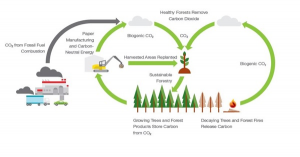
4. AIR POLLUTANTS IMPACT IMMUNE CELLS IN CAUSING CANCER
THE CONTEXT: According to the latest research by Zhenzhen Wang of Nanjing University, China, experts believe that the new findings may lead to new approaches for treating the initial lung changes that eventually progress to cancer.
THE EXPLANATION:
- Air pollutants have many forms. Apart from gaseous chemical components like carbon, nitrogen, sulphur, etc., some tiny powdery particles also contribute to air pollution. These inhalable fine particulate matter (FPM) that circulate in the air have already been recognized as carcinogens. These particulate matters are now considered a substantial threat to global health. Although their role in the genesis of cancer is widely acknowledged, the mechanism through which they develop the disease remains largely enigmatic.
- In this context, it is worth mentioning that the highly complex cancer disease also involves cells from our immune system (our body’s defence mechanism).
- Some immune cells play a crucial role in preventing cancer progression by destroying the cells where cancer has been initiated.
According to the study,
- To explore the indirect way through which the FPMs can exert their impact on cancer progression, the researchers first collected samples of FPM from seven locations in China. The team then attempted to analyze their effects on a particular kind of immune cell called the cytotoxic T cells (CTL).
- The CTLs play a crucial role in defending the growth of tumours. The researchers first administered lung cancer cells in mice not exposed to FPM. In these mice, induced with lung cancer cells but unexposed to FPM, the important immune cells were recruited to the lung to destroy the tumour cells. On the other hand, the researchers conducted the same experiment with mice administered with lung cancer cells and exposed to FPMs.
- They found that in the second set of mice, the movement of CTLs was delayed, which concomitantly allowed the tumour cells to grow and establish in the lung tissue.
- The FPM exposed lung tissues got dramatically compressed up to the level where the space between the lung tissue and the space where CTLs move became congested. In addition, the researchers found that there was a high level of collagen.
| Collagen is a protein that provides biomechanical support for both tissues and cells. The lung tissues of the mice exposed to FPMs, due to the constriction had a significant effect on the movement of the CTLs. |
- The CTLs struggled to move into the FPM exposed lung tissues where tumour formation had started.
- They further analyzed the lung tissues and found that they showed structural changes because of an increase in a particular type of collagen known as collagen IV. However, the team could not find any clue how FPM triggered this. Nevertheless, they found another hint. The enzymes, known as peroxidasin, make the collagen drive a specific type of situation, leading to the collagen formation becoming absurd.
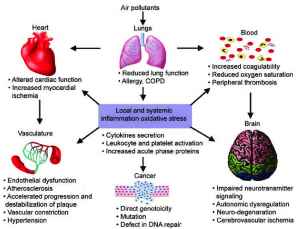
PLACES IN NEWS
5. FALKLAND ISLANDS
THE CONTEXT: The Government of Argentina will launch a campaign in India demanding negotiation with the United Kingdom to settle the territorial dispute over the Islas Malvinas that are known as the Falkland Islands in the UK.
THE EXPLANATION:
The initiative, which comes two days after the visit of UK Prime Minister Boris Johnson, coincides with the 40th anniversary of the conflict between the UK and Argentina, which ended with the re-establishment of British control over the archipelago.
ABOUT FALKLAND ISLAND:
- The Falkland Islands are an archipelago in the South Atlantic Ocean on the Patagonian Shelf.
- As a British overseas territory, the Falklands have internal self-governance, and the United Kingdom takes responsibility for their defence and foreign affairs. The capital and largest settlement is Stanley on East Falkland.
- Argentina has maintained that the Falklands were illegally taken from it in 1833 and invaded the British colony in 1982. That incident resulted in what later came to be known as the Falklands War which lasted a little over three months, ending in victory for the United Kingdom.

THE MISCELLANEOUS
6. WORLD MALARIA DAY
THE CONTEXT: On April 25, 2022, the Union Health Ministry organized Malaria awareness campaigns and events across the nation on the occasion of World Malaria Day.
THE EXPLANATION:
- World Malaria Day 2022 will be marked under the theme “Harness innovation to reduce the malaria disease burden and save lives.” No single tool that is available today will solve the problem of malaria.
- WHO is calling for investments and innovation that bring new vector control approaches, diagnostics, antimalarial medicines and other tools to speed the pace of progress against malaria.
- The Global technical strategy for malaria 2016–2030 was adopted by the World Health Assembly in May 2015. It provides a comprehensive framework to guide countries in their efforts to accelerate progress towards malaria elimination. The strategy sets the target of reducing global malaria incidence and mortality rates by at least 90% by 2030.
QUICK FACTS
|
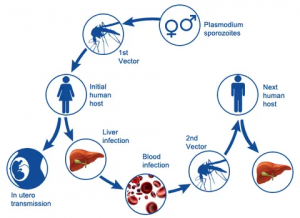
Status:
- According to World Health Organization (WHO) has launched the World Malaria Report 2021, highlighting the havoc malaria continues to wreck on the world’s poorest and most vulnerable.
- An estimated 14 million more cases and 69,000 more deaths were caused by malaria in 2020 compared to 2019. India was the only high burden country to record progress by sustaining a reduction in malaria burden between 2019 and 2020. However, the rate of decline was slower than before the pandemic, the WHO report stated, with the country still sharing over 80 percent of the malaria burden of South-East Asia.
- The WHO report also highlighted sizable gaps in malaria funding, as the demand to sustain progress increased to a year to $6.8 billion with only a tiny increase in malaria funding. In the South-East Asia region, the malaria funding per person at risk in India has been slower than the neighboring countries, stated the report.
THE PRELIMS PRACTICE QUESTIONS
QUESTION OF THE DAY
- Which of the following carries out an all-India survey on household consumption expenditure?
a) Labour Bureau
b) Union Ministry of Finance
c) Union Ministry of Home Affairs
d) National Statistical Office
ANSWER FOR 23RD APRIL 2022
Answer: B
Explanation:
